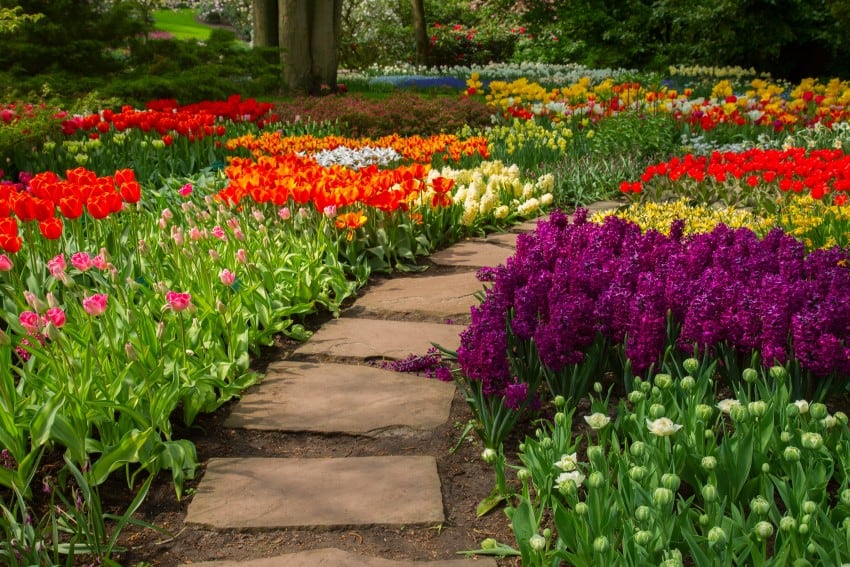Creating a beautiful garden is often on people’s minds as the summer approaches, but while avid amateur gardeners are quick to fill their outside spaces with all kinds of plants, it’s now more important than ever to consider the environmental impact of your garden and work towards making it friendly for all kinds of wildlife as well as welcoming and attractive to humans.

Some key summer garden trends this year include taking inspiration from current interior design trends and filling your garden with bold colours – yellow, orange and red are expected to be the focus this year with previously popular pinks and purples taking a back seat.
While pink and purple flowers are usually more attractive to butterflies and bees due to the ultraviolet light they give off, yellow and red flowers can still be highly attractive and keep your garden on-trend.
Another key trend gaining traction is the concept of a wild garden, flowers like poppies and daisies will be popular, along with grassy areas to give your garden the feel of a wild heath.
This trend is ideal for pollinators and a number of plants on our list will help you achieve the perfect wild garden.
1. Hydrangeas
Hydrangeas were named best flower at the Chelsea Flower Show 2018, meaning it’s sure to be filling gardens around the country in 2019 too. These typically purple and pink flowers provide loads of sources of nectar for pollinators and are likely to attract bees and butterflies throughout the summer.
2. Sulphur cosmos
The sulphur cosmos is a yellow flower originating from South America and is ideal for bees and butterflies. The flowers are yellow in the centre radiating out to orange around the edges of the petals. This flower is right on trend and is actually recommended as one of the top bee-friendly plants by the Royal Horticultural Society.
3. Sunflowers
The central head of a sunflower is actually made up of many unopened flower buds, each filled with nectar for attracting bees and butterflies. Large sunflower heads also provide a great place for insects to land and rest while they gather pollen.
Additionally, when sunflowers stop flowering, the large seedhead left behind provides essential oils and nutrients to birds such as nuthatches and long-tailed tits. Red sunflowers will help mix up the colours of your garden and add bold, interesting shapes.
4. Coneflowers
Coming in a beautiful range of colours, coneflowers are another plant filled with nectar to attract pollinators to your garden. These plants are perfect for bees, butterflies and even songbirds. Bees and butterflies drink the nectar and songbirds enjoy eating the seeds from large seedhead left behind when the flowers die.
5. Marigolds
Another mix of on-trend colours, marigolds are a rich red in the centre, spreading out to brilliant yellow at the edges. Honeybees are highly attracted to marigolds, so including them in your garden is likely to increase their presence.
Marigolds also give off a scent which is said to be unattractive to other insects like wasps and hornets, helping to keep your garden free of pests and more welcoming to humans.
6. Dahlias
Typical dahlias have heads of many flowers forming beautiful pom-poms but these plants can sometimes make it too difficult to reach the nectar for some times of bees and butterflies. Single-bloom dahlias are similar to daisies in their appearance, helping create that wild garden look while also drawing in insects.
7. Buddleja
Known as the ‘butterfly bush’ this is another plant expected to be popular this year as a way of drawing in pollinators. Buddleja form huge flower heads which provide lots of nectar opportunities for butterflies, moths and bees to snack on. Buddleja also come in a variety of colours. A variation called strawberries and cream flowers in pink and white for a splash of soft colour.
8. Red valerian
Red valerian plants are particularly popular with the painted lady butterfly, which migrates all the way from North Africa to the UK during the summer. These plants provide a source of nectar but also a place for the painted ladies to lay their eggs, meaning your garden could be filled with painted ladies as summer passes and into September.
9. Grasses
As previously mentioned, wild gardens are expected to be popular this year and planting combinations of grasses in sections of your flowerbeds will help lend to this wild feel. Stiff grasses also provide a useful place for butterflies and moths to lay their eggs, helping to support them throughout every stage of their lives.
10. Daisies
Although commonly seen as a weed, there are many types of daisy which will help brighten your garden this year. Variations like the gerbera daisy come in a vibrant red and provide a source of nectar for butterflies and bees. Daisies also lend themselves well to a wildflower-style garden for a great combination of 2019 trends.
Although it’s great to have a garden you can show off to your human friends, planting flowers from this list will make your outside space a hit with your animal friends too!
This article was provided by Damon Culbert from Complete Holiday Homes, luxury holiday homes in Hampshire.
Related Posts
- 6 Different Types of Soil for Gardening – How to Identify and Improve Each Type
- Landscaping with Rocks vs Mulch with Pros and Cons
- How to Create a Low Maintenance Garden
- 5 Benefits of Having Artificial Grass for Your Pets to Play On
- 12 Main Pros and Cons of a Pea Gravel Patio for Your Home
- Want to Redo Your Lawn? Here Are Your Options
Leave a Reply